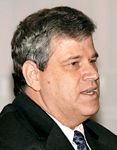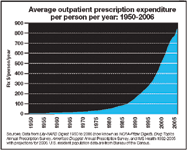Viewpoint: Is the growth in our drug tab sustainable?
The levels of drug use and expenditures have changed dramatically in the past 150 years. From 1857 to 1929, information on these trends was largely anecdotal in nature. It was only in 1929 that the Department of Commerce reported its first annual census of prescription drug distribution. This was followed, in 1932, by the first annual financial analysis of independent pharmacies, supported by Eli Lilly. Then in 1939, Drug Topics conducted its first annual prescription census, using a representative sample of drugstores from every state. What follows are some observations about trends in drug pricing, using the sources cited above as well as others.

Prescription expenditures. Just before the Great Depression, in 1929 to be exact, the United States spent $208 million on prescriptions. By 1954, this had zoomed to more than $1 billion. Then by last year, just 38 drug products accounted for more than $1 billion. In 2006, prescription drug spending at the retail level was estimated to be about $251 billion. All of the drug expenditure levels reported above include only retail prescriptions.

Annual prescription use per person. Use of prescriptions on a per-capita basis has also grown exponentially in the past 75 years. In 1929, the average U.S. resident received 1.85 Rxs per year. During 2006, the annual per-capita prescription use rate is projected to be 13.7.

Annual prescription expenditures per person. The annual per-capita expenditure on Rxs was $1.71 in 1929 and represented 0.25% of the average annual personal income. By 1970 the annual per-capita Rx expenditure had grown to $21.30, which accounts for 0.52% of an individual's personal income. This annual per-capita Rx spending has continued to grow rapidly, to an estimated $843.16 in 2006, which is about 2.38% of personal income.
In summary, Rx drugs have increased considerably in both their use and costs over the past eight decades. From 1929 to 2006, the U.S. resident population grew about 2.5-fold, while personal income grew more than 50-fold. However, the prescription use rate advanced even more-by 7.4-fold-while the average Rx price increased more than 66-fold. The combined effect of these factors was nearly a 500-fold increase in per-capita spending on prescription drugs from 1929 to 2006. Finally, this means that individual Rx spending grew about 10-fold as a share of one's personal income over this period.
Will drug growth patterns continue to expand at this blistering pace over the next 150 years?
THE AUTHOR is director of PRIME Institute at the University of Minnesota, College of Pharmacy.